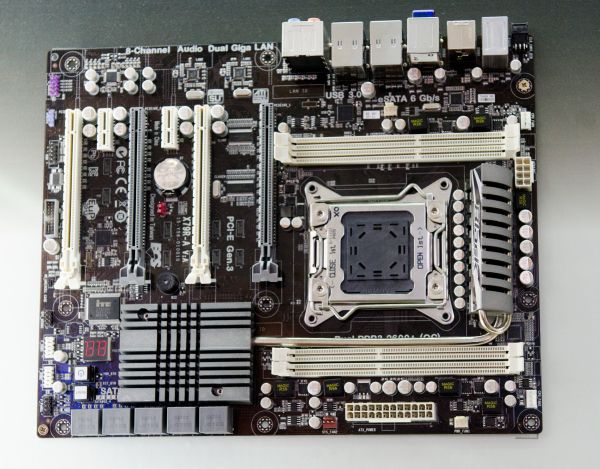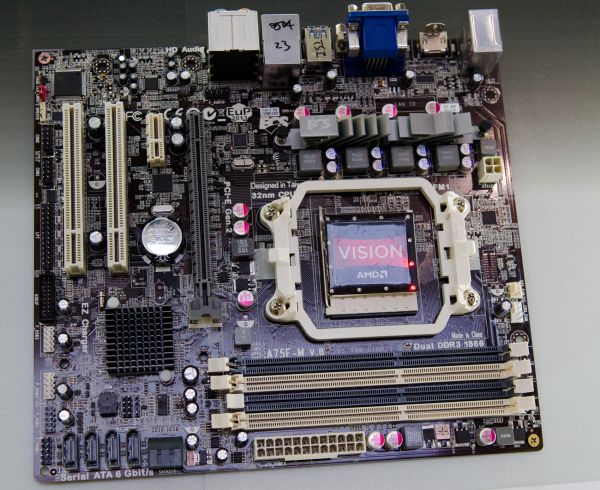Computex 2011: ECS X79 and Llano Motherboards
by Anand Lal Shimpi on May 30, 2011 11:35 PM EST- Posted in
- Motherboards
- AMD
- Intel
- 1000W
- Llano
- ECS
- X79
- Computex 2011
I’ve been running around the Computex show floor all morning and finally managed to build enough of a lead ahead of my meetings to sit down and write up some of what I’ve seen.
Ian is going to be meeting with most of the motherboard makers at the show but I just stopped by ECS’ booth and got a look at its lineup of three Socket-FM1 Llano (A-series APU) motherboards and a Socket-2011 Intel X79 motherboard for use with Sandy Bridge-E due out later this year.
SNB-E has four 64-bit DDR3 memory channels which makes routing a pain. Motherboard manufacturers are dealing with the incredible number of traces by splitting the channels up and routing half of them on one side of the CPU and the other half on the other. LGA-1366 boards by comparison had all six slots on a single side of the CPU, but there were "only" three channels.
ECS is going to be shipping both ATX and microATX Llano boards later this summer. As I mentioned earlier, Llano will first launch as a quad-core mobile solution with dual-core and desktop versions following later.


















19 Comments
View All Comments
cmircea - Sunday, June 5, 2011 - link
What is this bullshit with impossible to route traces? How come the likes of Supermicro, Quanta and Tyan can do it with not only four, but EIGHT DIMMs, but ASUS and others can't?Here's a definite example:
http://www.supermicro.com/Aplus/motherboard/Optero...
It has eight DIMMs, quad-channel, in ATX form factor, with six expansion slots. It also has the DIMMs in line with airflow, parallel to the top of the motherboard - this way they don't need heatspreaders since air moves between them from the front of the case.
How come Supermicro can use an extra PCB layer and ASUS can't? This excuse is just bullshit. They are cutting cornes on their highest-end motherboards to save a few cents off each motherboard, then forcing everyone else to redesign heatsinks and memory heatspreaders (cause they're too stubborn to put the DIMMs in their proper orientation).
genscar88 - Monday, October 17, 2011 - link
Apparently the DIMMs for 2 memory channels either side of the CPU package was a design choice by Intel and according to many articles I have read so far the manufacturers at this stage of development either are not allowed to or are reluctant to move away from that design. I have also seen an article in which they claim an MSI engineer is "concerned" about the 2 memory channels either side of the chip and that the choice to do it differently was solely Intels decision and manufacturers are not really to diverge from that design at this stage.I would expect larger boards, better component placement, heck maybe even BGA enthusiast desktop boards in the future sometime sporting the Socket R and 8 quad channel DIMMs along with a host of other goody's. It is only early days yet, I personally would be waiting for at least the second round of production after release of the platform in order to get a decent board.
genscar88 - Monday, October 17, 2011 - link
oh yeah and that board you linked is an Opteron Server based board, different chip manufacturer, different chipset, different platform, you cant really compare the two. Server boards have had 8, sometimes 16 DDR3 slots all clumped together for years, I actually saw one with 16 slots in 8 banks of 8 on a BGA server board and right below that was 4 processor sockets.Or this Server Board for instance, 4 CPU sockets, and 32 DDR3 sockets, for the same platform as you linked above.
http://www.tyan.com/product_SKU_spec.aspx?ProductT...
naeonline - Tuesday, May 31, 2011 - link
I know that all the SandyBridge systems with 4 dimms can support up to 32GB of RAM but you can hardly find any DDR3 modules that are 8GB without ECC. I'm finding to get more than 16GB I have to go with x58 and the 6 dimms they have.Wardrop - Wednesday, June 1, 2011 - link
I was looking 4GB DDR3 modules less than a year ago, and the pricing was about $200 each, and that was only for some really basic Kingston Value RAM (not to mention they were very hard to find). Less than a year on, and you can now get 4GB DDR3 modules for $50. That's the nature of RAM. You'll probably find the same with 8GB modules. When they do become available (which should be soon), they'll likely cost 2, 3 or even 4x more than 2x 4GB modules, but if you wait, the price will crash and the market will become flooded with 8GB modules.enbeuu - Saturday, August 6, 2011 - link
Yes, I agree, since DDR3 became the standard; module pricing dropped like a rock.I found the best prices to be on Amazon...back in the day when Quad was just introduced.
I'm looking for the 8GB modules because my MSI MOBO...has lost the pressure clip on the DDR3 rail...
Thus one rail can't be used, it's still overkill for me with 12GB total RAM DDR3; I'd like to fill the 3 functional slots with 3X8GB yielding 24GB total RAM. without reinstalling everything on a new MOBO; just because.
End of summer 2011 for 8GB modules DDR3?; maybe fall?
macky_r - Wednesday, June 1, 2011 - link
On the Intel board, it says PCIe Gen 3. Is that mean it's shipping with LGA 2011?! Holy !@$!Shadowmaster625 - Wednesday, June 1, 2011 - link
It may be true that one day your system will need more than 16GB of RAM. But I seriously doubt 16GB will not be enough during the useful life of SNB-E. You know that in 3 or 4 years there's going to be a $100 motherboard/cpu combo that will perform just as well with only 2 DDR4 channels. That's why I dont get all this talk of 32GB of RAM.henhaohenhao - Wednesday, July 13, 2011 - link
Come go and see, will not regret it Oh look
http://www.ifancyshop.com